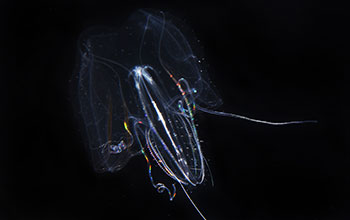Multimedia Gallery
Large ctenophore Leucothea
Leucothea is a large (20 centimeters) ctenophore found only in shallow waters. They feed while swimming forward (which is up in this photo), with their lobes spread like the wings of a biplane.
More about this image
Through a grant from the National Science Foundation's (NSF) Dimensions of Biodiversity program (grant DEB 15-42679), marine scientists Steven Haddock of the Monterey Bay Aquarium Research Institute, Joseph Ryan of the University of Florida and Erik Thuesen of Evergreen State College are studying how comb jellies exist in the deepest ocean realms.
Also known as ctenophores (pronounced teen'-oh-fours), comb jellies are marine predators found in all oceans, living in both shallow and deep waters. The luminescent drifters are named for the eight rows of shimmering combs that line their translucent bodies. The teeth of these combs are tiny vibrating hairs that propel the creatures through the water. At night, comb jellies glow bright green or flash eerie blue light when disturbed by boaters or swimmers. Like fireflies on land, they produce their otherworldly glow by a chemical reaction involving a light-emitting enzyme.
They are not true jellyfish and they don't have (or need) the stinging tentacles that bell-shaped jellies have. Instead, they use adhesive cells to snare prey, ingesting whatever small creatures they come into contact with as they float along. Vacuum cleaners of the sea, swarms of comb jellies can devour whole patches of freshly spawned fish eggs in a matter of hours.
Haddock, Ryan and Thuesen are using the newest molecular biology techniques to understand ctenophore evolution and diversification, and to investigate the deep sea as a generating force of new adaptations in comb jellies.
The researchers are using scuba expeditions and remotely operated submersibles to collect samples from shallow water and deep-sea habitats to measure ctenophores' physiological capabilities and to sequence their genomes. The results will help scientists understand how animals adapt to life in extreme environments.
To learn more about this research, see the NSF Discovery story Luminescent ocean drifters hold keys to deep-sea animal adaptations. (Date image taken: March or June 2017; date originally posted to NSF Multimedia Gallery: Nov. 28, 2017)
Credit: Steve Haddock
See other images like this on your iPhone or iPad download NSF Science Zone on the Apple App Store.
Images and other media in the National Science Foundation Multimedia Gallery are available for use in print and electronic material by NSF employees, members of the media, university staff, teachers and the general public. All media in the gallery are intended for personal, educational and nonprofit/non-commercial use only.
Images credited to the National Science Foundation, a federal agency, are in the public domain. The images were created by employees of the United States Government as part of their official duties or prepared by contractors as "works for hire" for NSF. You may freely use NSF-credited images and, at your discretion, credit NSF with a "Courtesy: National Science Foundation" notation.
Additional information about general usage can be found in Conditions.
Also Available:
Download the high-resolution JPG version of the image. (2.7 MB)
Use your mouse to right-click (Mac users may need to Ctrl-click) the link above and choose the option that will save the file or target to your computer.

 All images in this series
All images in this series